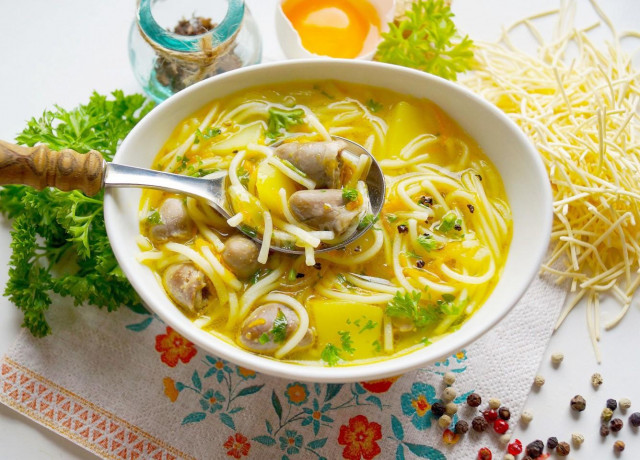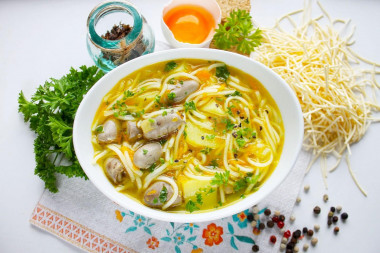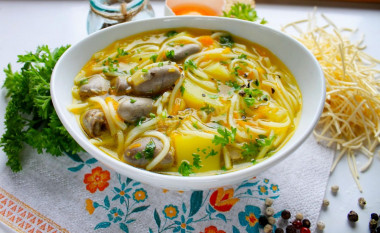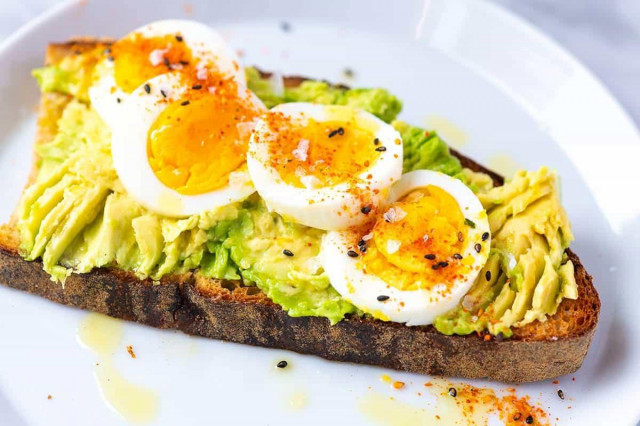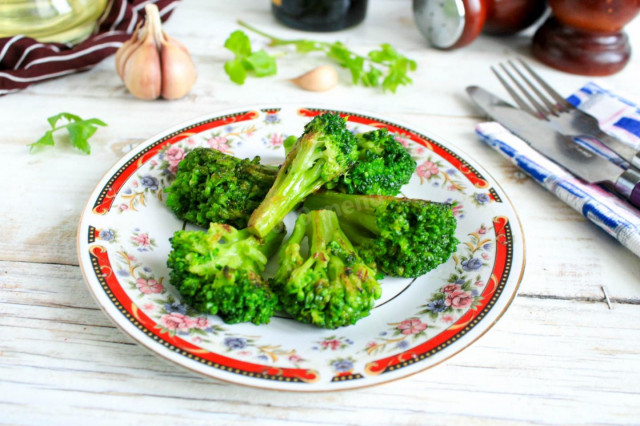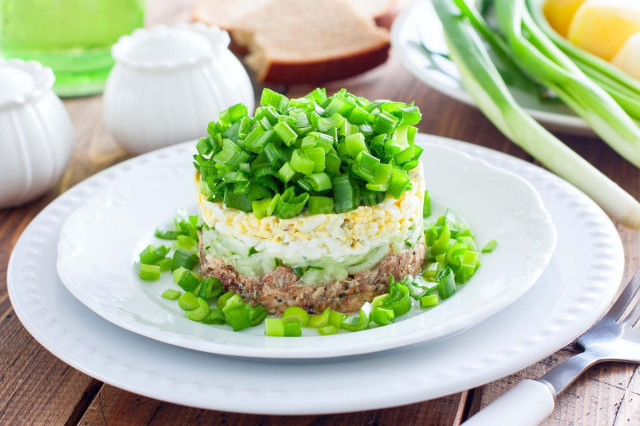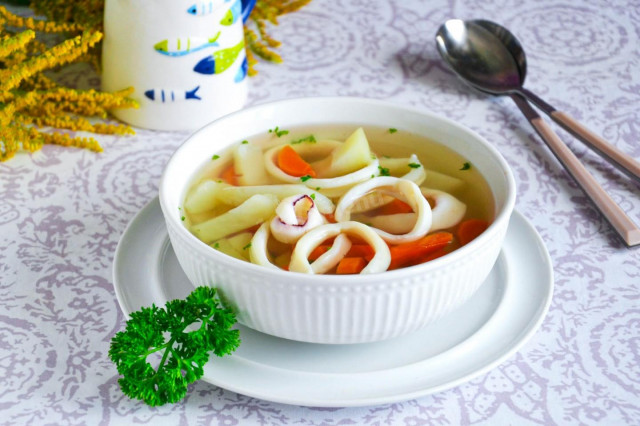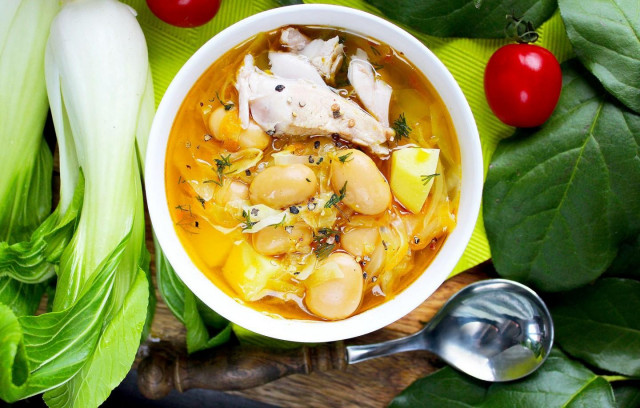Composition / ingredients
Step-by-step cooking
Step 1:
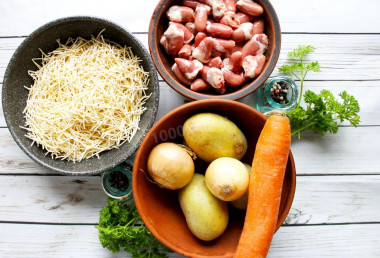
How to cook soup with chicken hearts and noodles? Prepare all the necessary products that are specified in the recipe. From greens, dill, parsley or young onions are perfect for soup.
Step 2:
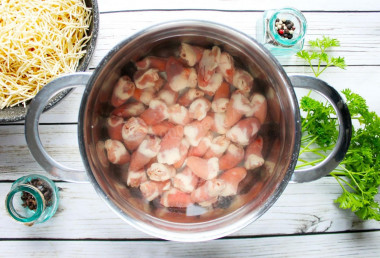
Rinse the hearts several times in clean water. Remove large vessels and blood clots. The fat can be left, then the soup will turn out more rich. Put the hearts in a saucepan, fill with water and put on the stove. When boiling, foam forms, be sure to remove it with a large spoon, otherwise the broth will turn cloudy. Reduce the flame and cook the hearts for about 15-20 minutes.
Step 3:
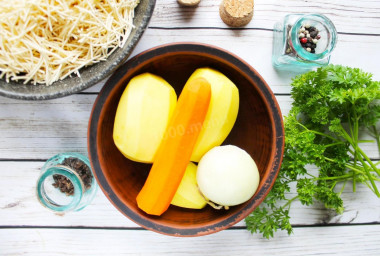
At this time, take care of the vegetables. Peel onions, carrots and potatoes and rinse.
Step 4:
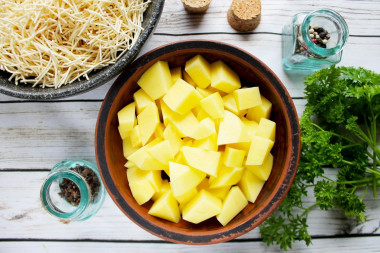
Cut the potatoes into small cubes or cubes, as you are more accustomed to.
Step 5:
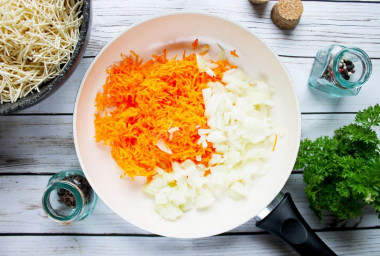
Chop the onion not very large, and grate the carrot on a fine grater. Heat a small amount of refined vegetable oil in a frying pan. Fry the chopped vegetables until the onion is transparent. Do not forget to stir the roast so that nothing burns.
Step 6:
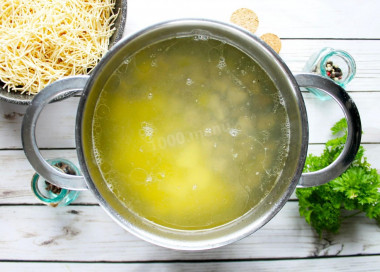
After the specified time, send the potatoes to the pot. Bring to a boil again on a high flame, then reduce the heat to moderate and cook the soup until the potatoes are ready. It will take you about 15-20 minutes.
Step 7:
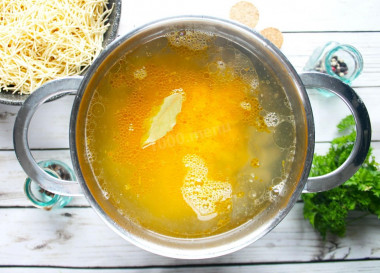
Send the roast and bay leaf to the pan. Add salt to the soup to taste. Make the stove to the maximum.
Step 8:
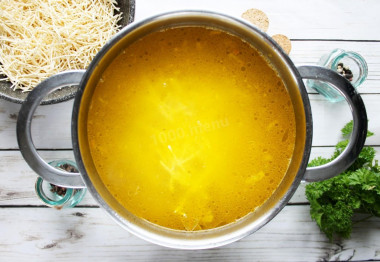
When signs of boiling appear, send the noodles to the soup and mix everything.
Step 9:
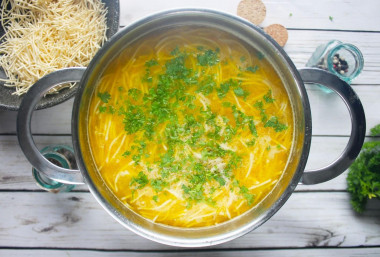
When the broth boils, add finely chopped greens to the pan. Turn off the flame, cover the pan with a lid and leave the soup to infuse for about 10-15 minutes. During this time, the noodles will reach full readiness. You can serve!
For the recipe, I used the purchased small egg noodles.
The soup will turn out even tastier if you make
homemade noodles by yourself,
but then the cooking time will increase.
If you have wide noodles, then it must be boiled over low heat until almost ready, and only then add the greens and turn off the stove.
Bon appetit!
Important!
Regardless of whether the amount of water for soup is indicated in the recipe or not, it is best to focus on your own preferences (thick or more liquid soup you like), as well as on the size of your pan and the products taken for cooking. Do not forget that the author has his own view on the amount of meat, potatoes, cereals and other ingredients in the soup, which may not coincide with yours. In practice, this means that if you are cooking for the first time, you should not cook a whole pot at once. Make a soup for tasting - for one or two people. To do this, reduce the amount of all ingredients according to the recipe to 1-2 servings, and take the amount of water from the calculation: from one cup per serving - if the soup is very thick, to 1.5-2 cups - if more liquid. Do not forget to take into account that part of the liquid will boil off during the cooking process. After tasting a small portion of soup, you can adjust both the amount of liquid and the proportions of ingredients to your taste. In the future, like most experienced housewives, you will be able to pour water for soup and lay the ingredients “by eye".
Use oil with a high smoking temperature for frying! Any oils are useful only until a certain temperature is reached - the point of smoking, at which the oil begins to burn and toxic substances, including carcinogens, are formed in it.
Unrefined oils, with rare exceptions, have a low smoking point. There are a lot of unfiltered organic particles in them, which quickly begin to burn.
Refined oils are more resistant to heating, and their smoking point is higher. If you are going to cook food in the oven, on a frying pan or grill, make sure that you use oil with a high smoking point. The most common of the oils with a high smoking point: refined varieties of sunflower, olive and grape.
Caloric content of the products possible in the composition of the dish
- Onion - 41 kcal/100g
- Ripe potatoes - 80 kcal/100g
- Baked potatoes - 70 kcal/100g
- Mashed potatoes - 380 kcal/100g
- Boiled potatoes - 82 kcal/100g
- Potatoes in uniform - 74 kcal/100g
- Fried potatoes - 192 kcal/100g
- Carrots - 33 kcal/100g
- Dried carrots - 275 kcal/100g
- Boiled carrots - 25 kcal/100g
- Bay leaf - 313 kcal/100g
- Vegetable oil - 873 kcal/100g
- Salt - 0 kcal/100g
- Noodles - 135 kcal/100g
- Water - 0 kcal/100g
- Chicken heart - 159 kcal/100g

